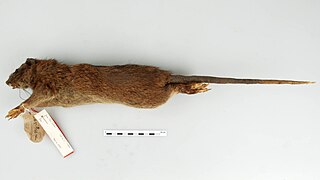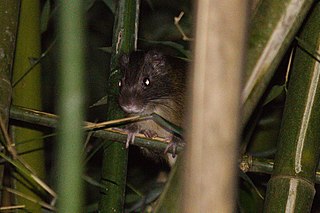
The Muroidea are a large superfamily of rodents, including mice, rats, voles, hamsters, lemmings, gerbils, and many other relatives. Although the Muroidea originated in Eurasia, they occupy a vast variety of habitats on every continent except Antarctica. Some authorities have placed all members of this group into a single family, Muridae, due to difficulties in determining how the subfamilies are related to one another. Many of the families within the Muroidea superfamily have more variations between the families than between the different clades. A possible explanation for the variations in rodents is because of the location of these rodents; these changes could have been due to radiation or the overall environment they migrated to or originated in. The following taxonomy is based on recent well-supported molecular phylogenies.

Papagomys is a genus of very large rats in the tribe Rattini of the subfamily Murinae, with body masses of 600–2,500 grams (1.3–5.5 lb). It contains two species, which are known only from the Indonesian island of Flores:

The Old World rats and mice, part of the subfamily Murinae in the family Muridae, comprise at least 519 species. Members of this subfamily are called murines. In terms of species richness, this subfamily is larger than all mammal families except the Cricetidae and Muridae, and is larger than all mammal orders except the bats and the remainder of the rodents.
Owl's spiny rat is a rodent species in the family Echimyidae found in Brazil. It is the only species in the genus Carterodon. Owl's spiny rat has evolved characteristics such as a heightened ability to dig in open grasslands during times of environmental change.

The Atlantic bamboo rat, or southern bamboo rat, is a spiny rat species found in humid tropical forests in Argentina, Brazil and Paraguay. It is the only member of the genus Kannabateomys.
Phyllomys is a genus of arboreal spiny rat, geographically restricted to the forests of eastern Brazil.

Olallamys is a genus of Andean soft-furred spiny rat that range from Panama through Colombia and Venezuela to northern Ecuador. These species are typically found at elevations above 2,000 metres (6,600 ft).
Margaretamys is a genus of rodent in the family Muridae endemic to the island of Sulawesi in Indonesia. Up until 1973, it was known from only few examples of one species. Then Guy G. Musser collected more examples of this species during his stay in Sulawesi, as well as collecting two new species. And in 1981, as part of his huge project of sorting through the then very large genus Rattus, he described these as members of the new genus, Margaretamys.
Annandale's rat is a species of rodent in the family Muridae. It is found in Indonesia (Sumatra), Peninsular Malaysia, and Singapore. It was classified as Rattus annandalei until 2017, but mitochondrial and nuclear DNA show that it belongs to the rat genus Sundamys.
Sundamys is a genus of rodent in the family Muridae, found mostly in Indonesia and Malaysia. It contains the following species:
Clyomys is a South American rodent genus in the family Echimyidae. It contains two species, found in tropical savannas and grasslands from circa 100 m (300 ft) to 1,100 m (3,600 ft) elevation in central Brazil and eastern Paraguay.

Echimyidae is the family of neotropical spiny rats and their fossil relatives. This is the most species-rich family of hystricognath rodents. It is probably also the most ecologically diverse, with members ranging from fully arboreal to terrestrial to fossorial to semiaquatic habits. They presently exist mainly in South America; three members of the family also range into Central America, and the hutias are found in the West Indies in the Caribbean. Species of the extinct subfamily Heteropsomyinae formerly lived on Cuba, Hispaniola, and Puerto Rico in the Antilles.
Halmaheramys bokimekot, the spiny Boki Mekot rat, is a rodent found on the island of Halmahera in the Molucca archipelago, whose discovery was announced in 2013. This is the only locality where this particular species has been found. H. bokimekot was confirmed as a new species through probabilistic methodologies applied to morphological and molecular data.
Louise H. Emmons is an American zoologist who studies tropical rainforest mammals, especially rodents. She has conducted fieldwork in Gabon, Sabah (Borneo), Peru, and Bolivia. Her best known work is the field guide, Neotropical Rainforest Mammals: A Field Guide, first published in 1990, with a second edition in 1997.
The Wallace's large spiny rat is a rodent found on the Obi Islands of Bisa and Obi in the Molucca archipelago of Indonesia.

Rattini is a very large, diverse tribe of muroid rodents in the subfamily Murinae. They are found throughout Asia and Australasia, with a few species ranging into Europe and northern Africa. The most well-known members of this group are the true rats, several species of which have been introduced worldwide.

Feiler's rat is a newly described species of rat from Indonesia. The species is known only from a holotype collected in 1938 on Taliabu Island, and stored in the State Museum of Zoology in Dresden. It is named after German zoologist Albert Feiler.
The Halmahera Island rat is species of rat endemic to the island of Halmahera in Indonesia.
The Obi Island rat is a newly described species of rat from Indonesia.
The Taliabu Island rat is a newly described species of rat from Indonesia.







